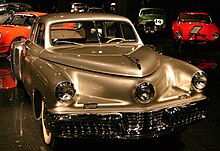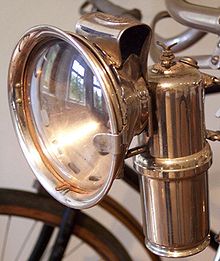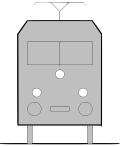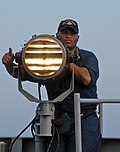Vehicle headlights

Vehicle headlights are headlights as part of vehicle lighting . They generally emit light in the direction of travel and are present or in use on almost every vehicle ; this is mandatory in many countries on public roads.
Their main functions are to illuminate the route directly in front of the vehicle for your own safety - recognizing obstacles - and for faster movement and for the safety of other road users in general and especially when visibility is poor.
They generally emit white (rarely yellow) light . Xenon light (only common in the automotive sector) emits a slightly bluish light, which is considered white and is therefore permissible.
Motor vehicles
In road traffic , the headlights also give a signal by informing other road users of the type of vehicle and the direction of travel through the arrangement of the lights . A pair of headlights, next to each other at the same height, usually indicates a multi-lane vehicle, while a single light usually indicates a single-lane vehicle. There are, however, exceptions, for example motorcycles with sidecars .
Front headlights, structural design




While single-lane vehicles usually have only one headlight, in multi-lane vehicles (usually automobiles) the headlights are usually paired. You are at the front of the vehicle; When reversing, the same (white) light is shown so that other road users are signaled that they are approaching.
Headlights are mostly used as low beam ; in addition also can high beams and fog lights are used. In 1957, the asymmetrical low beam was introduced in Germany: the edge of the lane on your own side of the street is illuminated considerably more than the opposite lane due to this asymmetry. This serves to avoid dazzling oncoming road users. This division of the light intensity thus serves traffic safety . Modern vehicles usually offer the option of adapting the illumination geometry when driving in countries for which the headlights are not intended ( left / right-hand traffic ). Before that, it was necessary to position the headlight within appropriate markings, e.g. B. wedge-shaped to mask to avoid glare.
The different lighting variants are functionally mostly combined in a structural unit (low beam, high beam , parking light ) and increasingly also with the direction indicators and installed in or below the radiator grille . Last but not least, this serves to optimize aerodynamics. Fog lights are often built into a separate housing and attached as far down as possible on the body.
Modern lighting devices often consist of a lamp which is arranged in front of a reflector . The light distribution can be designed with a combination of a parabolic mirror with a matching corrugated headlight glass (diffuser). Further developed headlights have specially shaped free-form reflectors for the targeted scattering and bundling of light , which are designed with the help of non-imaging optics and no longer correspond to any mathematical rule surface. They arise through the variation of the surface normals of the reflector surfaces according to the requirements of the light distribution. The reflector is often segmented into different areas. Then each segment can fulfill a specific part of the lighting task. Clear-glass headlights have largely replaced headlights with diffusers.
Alternatively, in the case of so-called projection lamps or projection headlights, a lens can also be mounted in front of the lamp instead of a reflector. Corresponding illumination is achieved through the geometry of the lamp and lens. This design is often found in xenon lamps, sometimes also in halogen lamps.
Today's headlight systems have two assemblies that take on the low beam and high beam function. The projection module for the low beam is increasingly controlled laterally with the help of a swivel module to enable the cornering light function. The swivel frame is controlled by a stepper motor based on the lateral acceleration in the vehicle, the steering angle and the driving speed.
The motorway light increases by approx. 50 m through a two-stage switch (various measures from 90 km / h and from 110 km / h). With "extended fog light", the light cone is pivoted 8 ° downwards and sideways to the left, which reduces self-glare. The well-known functions “active cornering light” and “cornering light” are also integrated. During tests, a data transfer to the following vehicle was established by sending light pulses from brake lights. The information about the braking deceleration can generate a brake pressure appropriate to the situation and the risk of rear-end collisions is reduced. Initial tests with LEDs showed a transmission over a distance of 130 m at 8 Mbytes / s.
With the latest lighting technology, the adaptive high beam assistant , the headlights are coupled with a camera with intelligent image analysis. The camera is able to control the range of the headlights and achieve ranges of up to 300 m - without dazzling other road users: the light / dark boundary always ends under the bumper of the next vehicle. If the camera does not recognize any other road users, the high beam is switched on automatically. Smooth transitions between all lighting scenarios ensure that the road is always optimally illuminated for the driver, without sudden changes in light. This makes it easier for the eyes to adapt to the new light setting.
Pop-up headlights are built into some sports cars . The headlight units are lowered into the body with a lever (e.g. Opel GT ) or an electric motor when not in use . In addition to the appearance, this is primarily due to aerodynamic reasons.
The so-called evil eye is an optical extension of the bonnet when tuning, which hides the upper edge of the headlights.
Four-wheeled road vehicles usually have two headlights or a pair of centrally symmetrical headlights. The historic, single-door small car Hanomag 2/10 PS ("Kommissbrot") only had one headlight in the middle, it also got by without an axle differential . Tatra (Czechoslovakia) also built car types with 3 headlights: Tatra 77 A (1934 / 5–1938), Tatra 87 (1937–1950), Tatra 603 from 1956, first series (3 relatively close to the center). Tucker 48 (1948, USA) had 3 headlights, the middle one swiveling into the curve. Motorcycles and all single-track vehicles usually have one headlight, but sometimes also two adjacent one above or next to one another, which are used alternately as low and high beam. These headlights are mostly round, sometimes also rectangular. Since the introduction of LED headlights, complex shapes have also appeared, including those that (with one light setting) give the impression of two nearby light-emitting surfaces. Motorcycles with sidecars typically have a second white light on the outermost edge of the sidecar, i.e. an asymmetrical front lighting situation according to their structure.
On motorcycles there are also paired, lower-lying auxiliary headlights . Additional headlights on cars on cars and trucks are typically available in pairs and symmetrically in the center. Hand-operated searchlights were often found in the middle behind the windshield on ambulances, but also a little in front of the side window on fire engines. Today hand-held or motorized searchlights are more likely to be mounted on the cabin roof. On trucks and off-road vehicles, there are sometimes additional headlights on the cab roof. If some additional headlights are not allowed to be used on public roads, they are sometimes covered with a hard or soft plastic cap, which also protects against stone chips and dirt.
Dipped beam for right-hand traffic is covered with black foil on the lens in left-hand driving countries so that dazzling is avoided.
Light sources
At the beginning of automobile history, lanterns attached to the side or on the bonnet without color filters were common, which were later replaced by electrically operated lamps .
In 1908, a dimming device was designed for the carbide lamps that were common at the time : a lever was operated via a Bowden cable , which moved the gas flame out of the focus of the reflector.
The two-filament lamp for combined high and low beam (BILUX ® lamp) was brought onto the market by Osram in 1925 ; from 1957 also for asymmetrical low beam ("BILUX-AS ® "), at that time at 6 volts.
The first H1 and H3 single- filament halogen lamps came onto the market around 1964. In 1966 Philips presented the two-filament halogen lamp H4 for high and low beam, but it did not appear on the market until autumn 1971 ( Mercedes-Benz 350 SL ). The brighter automotive halogen lamps (in H4 headlights) were initially relatively expensive: In 1976 the H4 twin-filament halogen lamp cost 20.40 DM and the H1 lamp 11.60 DM, which corresponds to € 26 and € 15, respectively, based on today's purchasing power .
With an average of 1,500 lumens, the H7 lights have a higher luminosity. Two such lamps are used in the headlight, since only one filament is used. The first light bulb is mounted in a special reflector, which causes illumination in front of the vehicle, with the second lamp also the high beam is switched on, which results in side illumination. First in the BMW 7 series and initially only as low beam, headlights with gas discharge lamps ( xenon light ) were used in 1991 as the last development for the time being .
In 2008, the use of light-emitting diodes was only permitted for taillights . In 2008, for example, the Audi R8 was the first vehicle with full LED headlights to go into series production thanks to a special EU permit. A year earlier, Lexus had already installed standard LED headlights in the LS 600 . New LED technology has halved energy consumption compared to halogen technology. The life of the LED of 10,000 hours could be enough for the life of a car. In 2006 Mercedes introduced the “ Intelligent Light System ” in the luxury class , which offers five different light functions. The country road light illuminates the left edge of the road over a wide area so that the visibility increases by approx. 10 m.
In 2014, BMW launched the i8, the first production vehicle with laser light . Laser diodes generate a blue laser beam for this purpose, which is converted into daylight white light by a layer of fluorescent material .
The lamps require an electrical supply voltage of 12 or 24 volts, the latter only being common in large vehicles such as mobile homes or trucks .
So-called retrofit LEDs are now available. These are intended to replace conventional halogen lamps and are therefore based on these in terms of design and lighting effect. However, none of these lamps has been approved in Germany so far.
Other headlights
Other types of headlights on motor vehicles are worklights and searchlights (common on off-road vehicles and construction machinery). Use while driving in public transport is prohibited.
Some special vehicles from emergency services or the police have headlamp systems that are used solely for stationary illumination of an object or site.
Camouflage lights are lighting devices at the front and rear of military vehicles that have changed in their luminosity and scattering . They have a light outlet that is significantly restricted by horizontal, slot-shaped openings (attachments) or headlights directed perpendicular to the road. Due to the minimal illumination of the street, these lights serve as camouflage from the enemy. Certain camouflage lights are also provided with red color filters.
Headlights on motorized two-wheelers

Headlights on motorized two-wheelers are almost always combined with high beam and mounted above the wheels in the middle of the longitudinal axis. Motorized two-wheelers rarely have more than one headlight. If so, all other must be in pairs in Germany (preservation of the signal image). Searchlights on two-wheelers are not permitted in public transport in Germany . In Germany, the low beam must be switched on at all times. The reason for this is solely traffic safety because of the contours of two-wheelers that are difficult to see from a distance . Parking lights are only available on high-quality models and are not required.
Others
As daytime running regular headlights or special daytime running lights can be used. In some countries it is compulsory to drive with the headlights on, even during the day. The use of daytime lights for motor vehicles is controversial in Germany.
Motor vehicle drivers can fade in (briefly switch on the high beam) to announce an overtaking maneuver (in Germany only outside built-up areas) or to indicate a danger. Furthermore, in some German federal states there is the so-called intermittent light in emergency vehicles, which is used when driving with special signals. The high beam is switched on and off automatically (frequency approx. 1 Hz ). Another variant is the so-called spring light. Here the high beam and fog lights light up alternately. Both variants are not permitted, as they represent a different lighting device than that specified in the road traffic licensing regulations. However, it is possible to deviate from this with an exemption. This was made use of in northern Germany in particular. The federal-state technical committee for technical motor vehicles has spoken out against the spring light because the permissible lighting equipment is sufficient to fulfill the sovereign tasks. In a letter to the highest road traffic authorities of the federal states of March 19, 2001 (Az. 33 / 36.25.61 / 001 BM 2001), the Federal Ministry of Transport took the committee's decision into account and prohibited the use of and the issuing of permits for spring lights. In addition, the dismantling of the existing facilities was ordered. However, in many places the order was not or only partially followed.
In some countries, replacement bulbs are generally required. Generally this applies to Spain, Serbia, Macedonia and Montenegro. In Croatia, Slovakia and Russia, replacement lamps are required, with the exception of LEDs and xenon lamps. Spare bulbs are recommended for France, Portugal, Hungary, Slovenia, the Czech Republic, Norway and the Netherlands, although this regulation is sometimes only applied to domestic vehicles. It is generally advisable to carry suitable spare lamps with you if replacement is difficult to find. With many vehicles, it is only possible to replace them in the workshop with greater effort. With the supplement 07 of the ECE regulation R-48, from August 2006 newer vehicles must be designed in such a way that a bulb change is possible without the use of tools. Xenon lamps still need to be replaced in the workshop.
National characteristics
In France, yellow vehicle headlights were mandatory for automobiles from 1937 to 1993; since 1993 they have been optional. In most other countries, however, white headlights are mandatory.
In many countries it is compulsory to switch the headlights on all day while driving - sometimes only outside of town, sometimes also in built-up areas.
Oddities
In the Austrian Motor Vehicle Act of 1967 , Federal Law Gazette No. 267, the typo headlight was to be found in several places for a long time . This was corrected at the end of 2014.
Rail vehicles

Rail vehicles usually have one to three white headlights facing the direction of travel. In Germany, Austria and Switzerland, as well as in some other countries, it is regularly in the form of the triple peak signal .
Vehicles that can travel in both directions have a full lighting system at both ends for forward and reverse travel. Since the peak signal only warns of an approaching rail vehicle and is not intended to improve visibility for the train driver, it is often not particularly bright. However, newer locomotives have additional high-beam headlights with which the route can be illuminated from a greater distance.
Ancient trams in Linz only had one central headlight. Today's trams often have a central headlight and two adjacent headlights underneath, thus also forming a triangle, probably to be more easily perceptible to other road users than when they are rail-bound.
Aircraft
In aircraft , headlights are used for take-off , landing and taxiing, as well as for better visibility. Small planes have one to two, large planes have two or more headlights.
Commercial aircraft mostly have their own headlights for taxiing on the ground ( taxi lights ) and for landing ( landing lights ). Landing lights are stronger and shine further upwards, would (like the high beam in a car) dazzle the pilots of other aircraft on the ground. Some aircraft also have flare lights shining downwards for better illumination of the runway during landing (e.g. De Havilland DHC-8 ). Larger aircraft are often equipped with “turnoff lights” for better lateral illumination of the taxiways.
In commercial and larger military aircraft, the landing lights are usually switched on below an altitude of 3,000 m (10,000 ft) in all visibility conditions in order to optimize their visibility for others and the environment. This applies in particular to other road users (pilots) and also to birds (see bird strike ).
Special circuits (Pulselight (R)) enable the left and right headlights to be switched on and off alternately to increase visibility. Some small aircraft have their own “recognition lights” suitable for continuous operation (roughly comparable to the daytime running lights of a car).
Since headlights have an aerodynamically unfavorable shape, they are often designed to be retractable. This can be done either by mounting it on the retractable landing gear or using its own retraction mechanism. Alternatively, headlights can also be installed under aerodynamic panels. However, if it is installed in the wing leading edge, this will interrupt the de-icing process .
Some military aircraft, as well as rescue , military, and police helicopters are equipped with searchlights . Some of the above-mentioned helicopters also have infrared headlights on board, which are used to illuminate observed objects for the infrared camera .
Watercraft
Position lights of relatively low luminosity are used on watercraft for regular travel . If necessary, search and work lights or deck lights are used, icebreakers use bright spotlights to illuminate the route in the ice at night.
On warships are Morse headlights sometimes still in use today. They are used for communication with one another, not for transport.
Cycles
→ Main article: Bicycle lights
Headlights are an important part of vehicle lighting for bicycles . Every bicycle in Germany must be equipped with a bicycle headlight. It is irrelevant whether the visibility conditions require it (exceptions exist for certain racing bikes ). They are equipped with light bulbs or LEDs.
The power supply is carried out depending on the system either by a bicycle dynamo or batteries. The voltage of ordinary headlights is 6 volts, the maximum power 2.4 watts. For headlights with LED light sources , in Germany the 10 lux regulation applies as the minimum requirement for light output, in Austria the bicycle regulation . Attachment kits are very often used for battery-operated headlights.
Individual evidence
- ↑ https://www. Zwischengas.com/de/blog/2015/11/26/Schwenkende-Scheinwerfer.html
- ↑ 100 years of OSRAM - light has a name. (Company publication Markenjubiläum 2006), (pdf; 4.66 MB).
- ↑ Dieter Korp : Audi 100. All models from August 1974 (= now I help myself 51). Motorbuch-Verlag, Stuttgart 1976, ISBN 3-87943-419-0 , p. 145.
- ↑ This figure was based on the template: Inflation determined and relates to the previous January.
- ↑ Difference H4 & H7 lamps | H7 light bulb test. In: h7-testsieger.de. Retrieved December 27, 2016 .
- ↑ Audi press release: First full LED headlights for the Audi R8 ( Memento from October 20, 2008 in the Internet Archive )
- ^ Intelligent Light System ( Memento from October 10, 2013 in the Internet Archive )
- ↑ BMW wins the battle for laser light against Audi. In: The world . June 5, 2014, accessed June 6, 2014 .
- ↑ a b Osram: Replacement lamp boxes , checked December 19, 2011
- ^ German motor vehicle trade: Other countries, other lighting rules ( Memento from June 26, 2015 in the Internet Archive ) June 2006, checked June 25, 2015
- ^ ADAC: Lamp replacement , October 2004, checked December 19, 2011
- ↑ Light duty during the day abroad. ADAC, accessed on August 5, 2014 .
- ↑ Federal Law Gazette I No. 87/2014 : Amendment of the Motor Vehicle Act 1967










